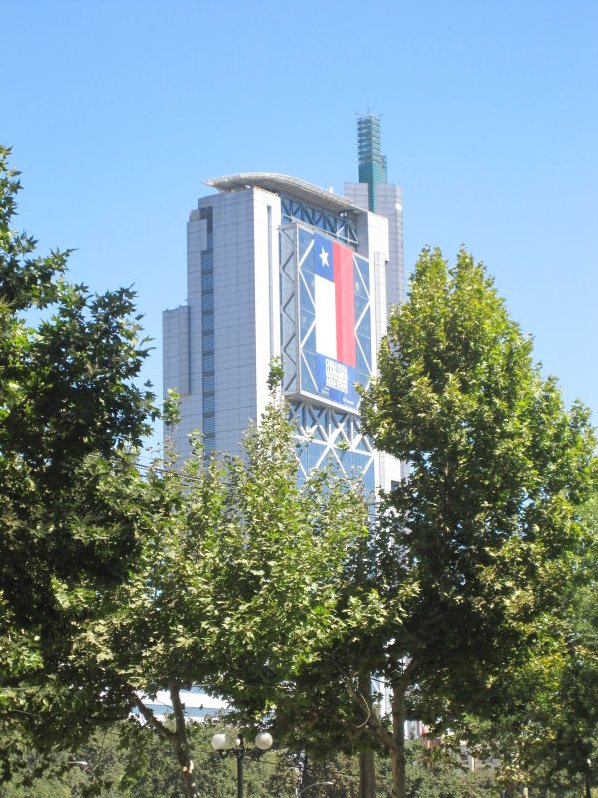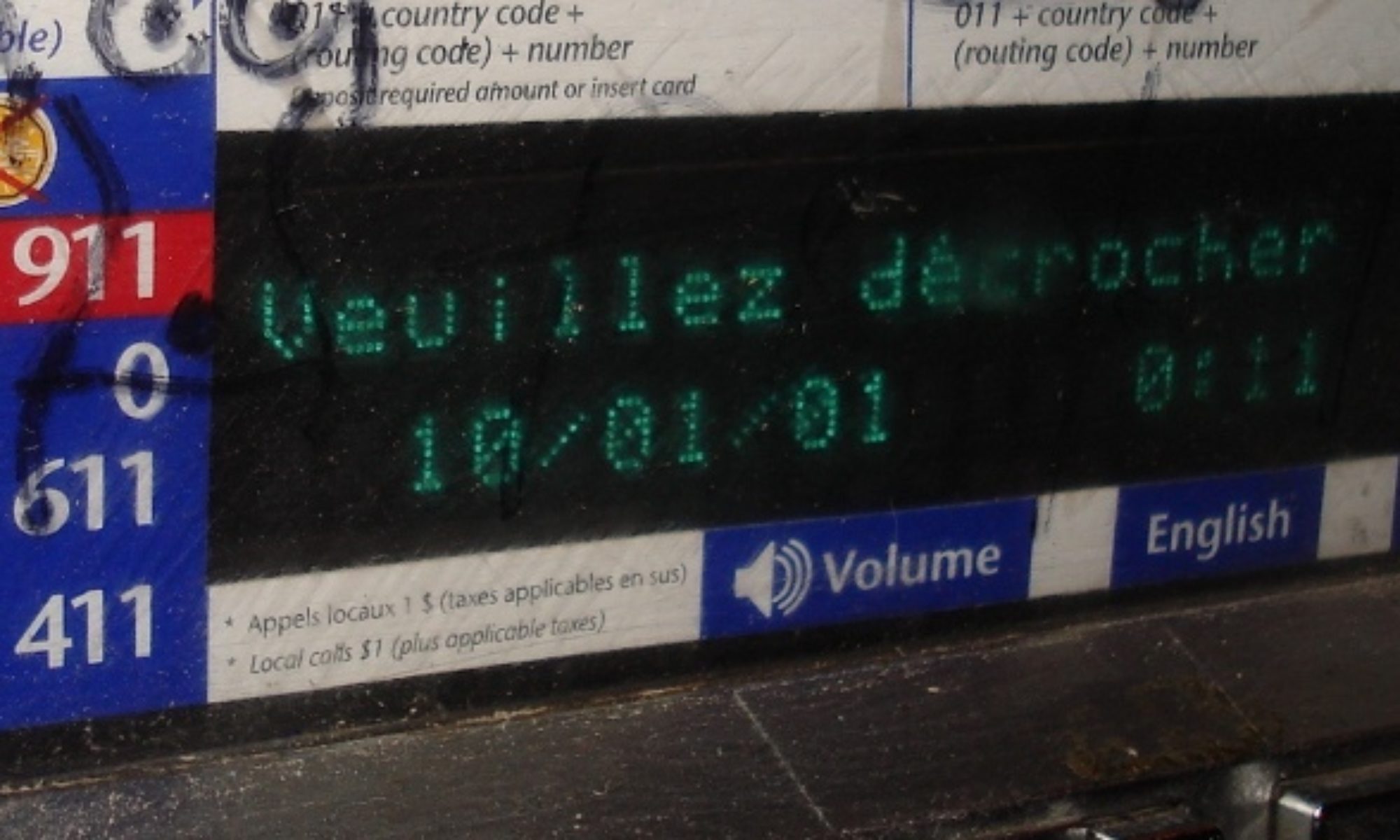
Perro, perro, perro… L had told me, and it didn’t take long to notice for myself, there are dogs running around everywhere in Santiago. It isn’t only in the residential neighbourhoods either: downtown, on the top of Cerro San Cristobal, seriously everywhere. A dog was even spotted in the Presedential transfer of power ceremony, taking a whiff of Presidente Bachelet.
For the most part, they’re neither friendly nor hostile. They just do their thing amidst the people, traffic and cats, creating a community that is indirectly dependent on the human population but mostly just sharing the space. L says there are as many dogs as pigeons in this city and that they are just another type of people, and I’ve come to agree on both counts. The inhabitants for their part are just as indifferent, stepping over snoozing dogs left and right. The only place I haven’t seen a dog yet is within the metro system.
Another thing we’re finding an abundance of is Chilean flags. There are flags everywhere, as well as messages of support for Chile both on large commercial banners and scribbled on the rear windows of cars and micros (buses).


This, I’ve learned, is a new phenomenon and is related to the recent series of earthquakes: a demonstration of solidarity. That’s why such a large swath of the pictures I’ve been taking that include buildings have banderas and tags related to strength and solidarity.
Today we headed back to Plaza des Armas and walked a few blocks north in search of the mercado central. It’s a large indoor market, where the delicate scent of 10 tons of raw fish greets you as soon as you enter the large sombre metallic structure. This is the first place I’ve seen where stray cats outnumber dogs.
The mercado centrale is a place where you keep one hand on your wallet at all times, and the restaurants are staffed with more scouts in search of patrons than waiters. Though there are all kinds of people in Santiago, and I blend in rather well with Chileans of german descent, my status as a foreigner was painfully obvious in this place even keeping my mouth shut.


After going through what L termed “the perfume aisle” twice, looking for a tempting place to try some pescado frito (fried fish) while doing our best to circumvent the ceaseless offers of great food and low low prices, we finally settled on Donde Augusto.
The view on the second floor mezzanine was great, the rest was not. A grumpy waiter handed us a menu with a hint of cat urine within, the grilled fish was undercooked and jiggly, the fried fish was good but had more “seasoning” than a salt mine and at the end our friendly waiter, who’d ignored us the entire meal, kindly pointed out that he expected a 10% tip. A luxury reserved for the gringos. Delightful. In short, Donde Augusto: not recommended.

It was there, however, that I tasted my first pisco sour—a mix of pisco (an alcoholic beverage, and an acclaimed local creation) and… uhm… sour. Tasted like strong lemonade, hit us both like a brick wall to the point that I wondered if it contained GHB, but was a nice buzz to head back out on.

We headed back to the plaza and spent a while basking in the sun and the screeching of a lady preaching about the end of days. Though most people are more relaxed on that front, religion is still a big thing in these parts. While some of L’s cousins are born-again types, you get a funny vibe from them as there’s a good mix of business with all the devotion. Around our temporary HQ in Nunoa, you can occasionnally hear christian music blasted in the street, and the aggresive (or is it tormented?) roar of self-appointed preachers on improvised P.A. Systems that sounds more like a call to revolution, alternating with cries for help, than a sermon. But from what I do understand it’s a lot more about the stick (diablos, infiernos and tiempo finales) than carrots. The response when refusing a pamphlet is a disapproving or disappointed look and a muttered “Jebus save them”.


We returned to barrio Brasil to spend some time with a few liters of Escudo (“shield”, whether against the sun or something else, I dunno), which is the beer of choice for most places with a patio. The brand is plastered everywhere there are bars, on the signs, the chairs and the waiters.

With a definite bounce in our step, we headed back south to Alameda (the common name for liberador O’Higgins boulevard) and did some chilling in the park which bisects the street. I’m still amazed at the amount of public space dedicated to relaxing amidst the greenery.


Everywhere you go, in el centro, tourist traps, poor residential neighbourhoods, housing subway entrances… you’ll find parks of all sizes with the occasional statue, work of art or playground but mainly dedicated to relaxing or getting from one place to another in agreable surroundings.
In contrast with the park spaces, which are beautiful, found everywhere, and in my opinion reflect a real respect of the human needs for beauty and respite, something you need to account and plan for is restrooms. They are rare, since most shops and restaurants you cross in the street are nothing more than a counter with a cash register, and unhappy places when you do find them.
Maybe it’s just that I’m a spoiled North American, and it’s true that we only spend a small percentage of our days in a bathroom, but the repetitive struggle that is dealing with cramped, malodorous spaces gets pretty tiring.
 Ironically, the common name for toilet paper here is Confort (meaning comfort but a brandname so ubiquitous that it became a synonym for all such products, regardless of actual origin, like Kleenex and Velcro) and most bathrooms are definitly without comfort, in both senses of the word. It’s a good idea to bring your own. Same goes for hand soap or sanitizer.
Ironically, the common name for toilet paper here is Confort (meaning comfort but a brandname so ubiquitous that it became a synonym for all such products, regardless of actual origin, like Kleenex and Velcro) and most bathrooms are definitly without comfort, in both senses of the word. It’s a good idea to bring your own. Same goes for hand soap or sanitizer.
In popular areas, and certain shopping malls, there are paying restrooms. They are relatively cheap (150-300 pesos, or less that 60 cents) and clean. Use them when you find them.

After relaxing in the park, basking in the dusk and the muted sound of continous traffic, we headed back to HQ from Republica station and got some much needed rest.



